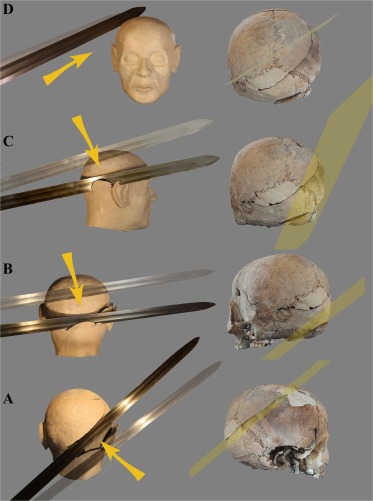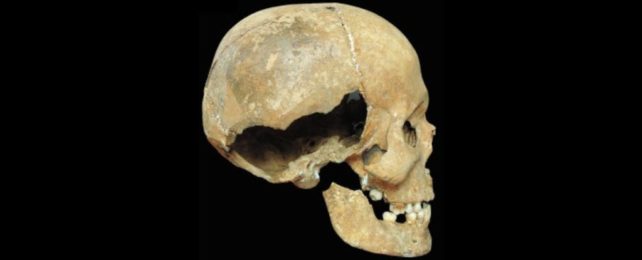Archaeologists have used a battered skull, found in the crypt of a Medieval Italian church, to reconstruct a brutal scene that took place more than 800 years ago.
The skull belongs to a young male, and because he was buried in the San Biagio's main atrium, he is thought to be a member of the wealthy De Cittiglio family who owned the land the church was built on.
A life of privilege was apparently not enough to save him from murder, an end he may have never even seen coming.
Researchers at the University of Siena and University of Insubria in Italy used four large lesions in the man's skull to determine a sequence of attack.
Physical examinations, three-dimensional digital microscopy, and CT scans of the bone can tell researchers the nature of an injury, the direction of an attack, and even the type of weapon that might have been used. In this case, the analysis suggests the initial attack came from behind and caused only a superficial cut in the bone at the back of the skull.
Perhaps the young man had been attacked by surprise and only just managed to block or dodge what could have been a fatal blow before attempting to flee.
The nature of the shattered bone suggests there was a single attacker coming at the victim from behind with a sharp metal blade, most likely a long sword.
"The victim, at that point aware of the attack and perhaps unprepared for the battle, must have attempted an escape while being hit from behind the head causing lesion C, which would have been immediately disabling, probably interrupting or at least slowing down the flight," the authors continue.
Lesion C, the team concludes, would almost certainly have removed the man's right ear, causing a minor hemorrhage. But it probably wasn't fatal, either.

Still, with two bone-cracking strikes to the skull, there was little chance of putting up a good fight. The third blow appears to have come right after, causing an even more powerful break at the lower rear of the skull. Forced forwards onto the ground, the victim may have had the fortune of losing consciousness at this point.
The final and most powerful blow, lesion A, would have finished the man off. It pierced a couple centimeters into the skull, no doubt causing brain damage and extensive bleeding. Death would have come in mere moments.
"The number and position of perimortem injuries, and the damaging power of the blows, showed the aggressor's intentionality and perhaps a certain overkill towards the victim," the authors write.
The unfortunate man's skull was unearthed in 2006, but this study is the first to use modern techniques to reveal the man's ending in his bones.
The findings help illustrate what life might have been like in Medieval Italy, around 900 to 1170 CE. It also shows the plausibility of using skull injuries to reconstruct the death of modern individuals in the field of forensics.
The man found at San Biagio certainly doesn't seem to have gone looking for trouble, but he clearly had experience with warfare in general. The authors say his right shoulder showed signs of habitual archery practice starting from a young age. Other parts of his skull also show signs of scarring.
Archaeologists might now have a better idea of how this man died, but without any historical records on him, why will remain a mystery.
The study was published in the Journal of Archaeological Science: Reports.
